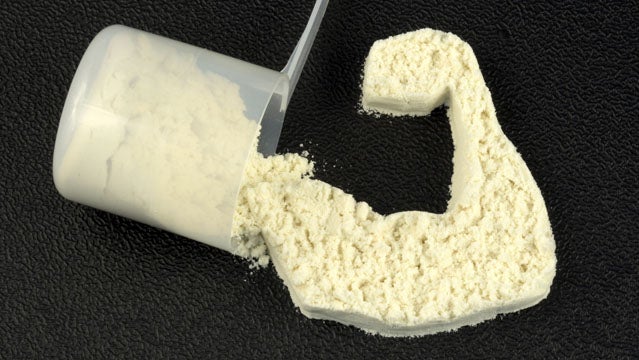ABSTRACT: As my coach always says, horsemeat equals horsepower. He’s dead serious, too. Up until the 1960s, steak was a crucial part of many pre-race diets. And sometimes steak just happened to be horse-something or another. That’s right: Who wouldn’t run a faster 100-meter dash after a 12oz donkey steak? Thankfully, the times have changed. Carbs are the key to performance, and we’re told to eat our protein in manageable 20-30 gram servings every three hours for optimal performance. But some scientists are now calling that research into question—maybe the body does better with a single large dose of protein. So who’s right?
The Explainer
⇢ Is There a Better, Faster Way to Train?⇢ Is Your Warm-Up Hurting Your Workout?
⇢ Why Kids Shouldn’t Focus on 1 Sport
HYPOTHESIS: There’s only so much protein your body can digest at a time. You’re best sticking with 20-gram servings of the muscle-builder.
METHODS: An looked at the relationship between the intake of essential amino acids and net protein synthesis across several studies. Unlike past research, the scientists were interested in both ends of the equation: Protein synthesis and protein breakdown.
RESULTS: After taking into account protein breakdown, the scientists found a simple relationship: The more protein, the better. In fact, they concluded that “there is no practical upper limit to the anabolic response to protein or amino acid intake in the context of a meal.” In other words, eat up.
DISCUSSION: Endurance junkies and gym rats know the routine. You need protein to make muscle. What’s less clear for lay-people: How much protein your body can handle at any point in time. Enter: myths and dogma. Often, we have only ourselves to blame for nutritional misunderstandings. But sometimes, technology makes a wonderful scapegoat. This is one of those latter cases, says the study’s lead author, Nicolaas E Deutz, M.D., Ph.D., editor-in-chief of Clinical Nutrition.
For years, scientists approached the question from the synthesis angle—how much protein your body produces to form muscle. And the seemed to suggest that 30 grams was the upper limit to what your body could use. But even at the time, the critics had plenty to say: The research wasn’t done post-exercise or in athletes. Somehow, the guidelines stuck: Eat every three hours and get in no more than 30 grams at a time, we’re told.
The researchers were missing out on some crucial information. “The people that did the research that 30 grams is the maximum, they measured only the protein synthesis in muscle, while if you want to build your muscle you need to increase your protein synthesis, but you can also—at the same time—reduce your protein breakdown. Or even, your protein synthesis can stay the same but if your protein breakdown is reduced, you’ll still build your muscle,” says Deutz. “Our argument is that the 30 gram information was only on the basis of protein synthesis, but the body will change to a different mechanism—which is reducing protein breakdown—if you take more than 30 grams.”
Imagine you want to know the quickest way to overflow your bathtub. Sure, you want to turn on the spigot, but should also check if the drain is closed. No matter how much water you dump into that tub, an open drain is going to prevent it from overflowing. And muscles work—with some major caveats—the same way. Not only can you influence how much protein synthesis goes on at any given moment, but you can regulate how much protein your body breaks down. You can turn on the spigot, but you can also shut the drain! And according to Deutz, eating more protein does just that—it shuts the drain.
Some related work seems to back up Deutz’s research. examined the effects of taking in 80 percent of a 1.5g protein/kg in a single meal versus over the course of the day. The results: The single meal model proved more anabolic, suggesting that your body can do well with more than 30 grams a meal. And pointed to the same conclusion. Subjects who fasted for 20 hours a day and had only four hours to down 101 grams of protein had similar levels of muscle mass and protein as those on a conventional diet.
So much for the 30-gram myth? Not so fast, says Asker Jeukendrup, Ph.D., professor of Exercise Metabolism at the University of Birmingham and the global senior director at the Gatorade Sports Science Institute. “Their argument would be that when you ingest more, you actually reduce protein breakdown and therefore the total amount of protein that adds to your muscle is increased,” he says. “I’m not convinced that the protein breakdown is actually reduced.” For now, Jeukendrup says 20 grams “is probably optimal.”
The experts may disagree, but it may be less consequential than you think. “Sometimes people focus on slicing and dicing these questions to the nth degree vs. making sure they get the big picture/take home message,” says Dr. Michael J. Joyner, a physician-researcher and one of the world’s leading experts on human performance and exercise physiology. The entire argument is situational: How much/what kind of exercise you’re doing, the timing of the meal, and how your meal interacts with insulin make every situation somewhat unique, he says.
Instead of dialing in your meals to the minute, aim for some overarching goals like getting in the right amount of protein across the entire day. And if you’re looking for an additional tweak, consider your goals: Are you trying to add muscle or simply aid in recovery, says Stacy Sims, Ph.D., co-founder of Osmo Nutrition. “If you’re trying to maximize recovery and not bulk up (i.e lean out instead of bulk), then 20-25g whey plus casein every four to five hours is best. If you’re trying to bulk up, then maximize protein with a meal post-exercise,” she says.
CONCLUSION: The jury’s still out, so focus on getting in the right amount of protein in the first place: 0.6 to 0.9 grams per pound of body weight for endurance training, up to 1.2 grams if you’re trying to pack on muscle.


